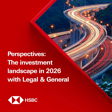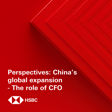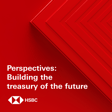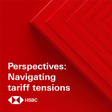Become a Creator today!Start creating today - Share your story with the world!
Start for free
00:00:00
00:00:01

Under the Banyan Tree - Can China’s new COVID measures stall the slowdown?
With COVID-19 cases soaring across China, Fred Neumann talks to Chief China Economist, Jing Liu, about Beijing’s new approach to containment and how it could impact the economic outlook for the country and beyond. Disclaimer. To stay connected and to access free to view reports and videos from HSBC Global Research click here.
Hosted on Acast. See acast.com/privacy for more information.
Transcript
Introduction to Podcast Series
00:00:00
Speaker
Welcome to HSBC Global Viewpoint, the podcast series that brings together business leaders and industry experts to explore the latest global insights, trends, and opportunities.
00:00:11
Speaker
Make sure you're subscribed to stay up to date with new episodes.
00:00:14
Speaker
Thanks for listening, and now onto today's show.
00:00:16
Speaker
This is a podcast from HSBC Global Research, available on Apple Podcasts and Spotify.
00:00:22
Speaker
Search for HSBC Global Viewpoint or join us via the HSBC Global Banking and Markets page on LinkedIn.
00:00:29
Speaker
However you're listening, analyst notifications, disclosures and disclaimers must be viewed on the link attached to your media player.
COVID-19 Surge in China: Economic Implications
00:00:45
Speaker
Welcome to Under the Banyan Tree, where we put Asian markets and economics in context.
00:00:50
Speaker
I'm Fred Newman, Chief Asia Economist at HSBC, and I'm joined today by Chief China Economist Jing Liu here in Hong Kong.
00:00:57
Speaker
On the podcast today, a fresh challenge for China as COVID-19 cases in the tens of thousands flare up daily across the country.
00:01:05
Speaker
Officials are fine-tuning their response to the pandemic.
00:01:08
Speaker
We'll be discussing the social and economic stakes involved right here on the Banyan Tree.
00:01:20
Speaker
China's daily COVID cases are edging increasingly close to a record high.
00:01:25
Speaker
At this time of recording, the country is reporting just under 30,000 new infections per day.
00:01:30
Speaker
For context, that's basically the level the country was at when the city of Shanghai, home to 26 million people, went into a two-month lockdown back in April.
00:01:41
Speaker
Officials in many of China's biggest cities are now trying to work out how to control the outbreaks without returning to the sweeping measures we've seen in the past.
00:01:50
Speaker
Cities are now following new guidelines announced earlier this month aimed at minimizing disruptions to people's lives and, of course, to the economy.
00:01:59
Speaker
Jing, help us set the scene here.
00:02:01
Speaker
How does the current flare-up compare to what we saw during the Shanghai lockdown back in the second quarter of this year?
00:02:09
Speaker
Thanks, Fred.
00:02:10
Speaker
So in terms of the number, now is near the record high we saw back during the spring in Shanghai lockdown.
00:02:17
Speaker
But in terms of the spread out of the cases, back then was more concentrated in Shanghai.
00:02:24
Speaker
Now it's spread out in many different cities.
00:02:27
Speaker
For example, the capital city of Beijing is
00:02:30
Speaker
Now see the cases rising both in Chaoyang District and Haidien District.
00:02:35
Speaker
Some of the students are now back to study from home mode again.
00:02:39
Speaker
Further in the West, Chongqing also battling its worst outbreak.
00:02:44
Speaker
And also Guangzhou, you have heard the news about certain districts under lockdown mode for a while.
00:02:51
Speaker
So we have a very wide geographic spread this time around affecting coastal regions, more of the inland cities as well.
00:02:59
Speaker
How has the response been different this time around to what we saw maybe earlier in the year?
China's New COVID Policies
00:03:07
Speaker
I think, you know, it's fair to say now is more targeted measures, especially after the 20 calibrated measures were announced in the early November.
00:03:19
Speaker
In particular, in the magnitude of the Guangzhou or Chongqing measures,
00:03:23
Speaker
outbreak.
00:03:24
Speaker
Under the previous policies, we would more than likely to see the lockdowns in those cities already.
00:03:30
Speaker
But this time around, we see much less preemptive lockdown.
00:03:34
Speaker
But in turn, the governments are trying to balance the economic growth and the COVID control.
00:03:43
Speaker
So recently we saw Beijing actually publish 20 specific guidelines to local governments to calibrate really the virus response in China.
00:03:54
Speaker
What are some of these specific guidelines that struck you as being new, as being kind of maybe a change in strategy, if you will?
00:04:03
Speaker
It's definitely more targeted and scientific in the following sense.
00:04:07
Speaker
For example, previously, lots of local governments seem to adopt a one size fit all.
00:04:13
Speaker
So you would see preemptive lockdown and mass testing quite usually.
00:04:19
Speaker
But now they're saying that mass testing should be restricted to areas where the community contingent has been going on for a while without clear source of contingent.
00:04:32
Speaker
And many cases are surging.
00:04:34
Speaker
And at the same time, they also forbid people from doing the testing twice or three times a day, which actually arguably not so much.
00:04:45
Speaker
scientific to start with.
00:04:46
Speaker
And on top of that, I think we also see in terms of the close contact, they are required to have the five days centralized quarantine with three days at home, but they no longer quarantine the close contact of the close contact, so-called the secondary contacts.
00:05:05
Speaker
So that's also an improvement.
00:05:07
Speaker
So we won't see so many people being taken to centralized quarantine facility, for example.
00:05:14
Speaker
So many of these measures you cite are really aimed at reducing the economic and even administrative burden of some of the earlier measures and help the economy to breathe a bit more under what's still a battle against the virus.
00:05:30
Speaker
Now, here, of course, the economic considerations are one thing, but the other consideration is clearly public health and there are risks.
00:05:38
Speaker
See, that's why we have these restrictions in the first place.
00:05:42
Speaker
Do you see any moves recently of perhaps stepped up preparations in China when it comes to dealing with the public health side of the virus?
Impact on Public Health and Service Sectors
00:05:54
Speaker
Yes, indeed.
00:05:55
Speaker
We have seen redoubling of the efforts on the ground.
00:05:58
Speaker
For example, in terms of the vaccination, the inhaled vaccines are now being administered in multiple areas, and that one is conceivably easier to do for the elderly group in particular.
00:06:14
Speaker
And also we see these domestically made antiviral treatment drugs being more widely accessible.
00:06:22
Speaker
At the same time, the authorities are building COVID-specific hospitals with an aim to assign about 10% of the beds as ICU,
00:06:33
Speaker
And they will have this tiered system in treatment, being the COVID-specific hospitals, the makeshift facilities, and also the clinics dealing with people with COVID-like symptoms.
00:06:48
Speaker
All right.
00:06:48
Speaker
Thank you very much, Jing.
00:06:50
Speaker
In part two, we'll discuss the impact of China's COVID measures on services and manufacturing, plus how all of this links to the recent headlines on China's volatile housing market.
00:07:09
Speaker
Welcome back.
00:07:09
Speaker
So Jing, when it comes to the type of containment measures we're seeing in China, it's really all about trade-offs.
00:07:15
Speaker
Where have we seen the biggest negative impact?
00:07:19
Speaker
Yes, I think similar as other economists, basically the containment measures have restricted social interaction.
00:07:25
Speaker
So as you can imagine, the service sectors, including retail sales, have taken a big blow.
00:07:31
Speaker
And on top of that, the small and medium-sized enterprises, due to their size and also most of them are in the service sector, they also get a big hit from the COVID outbreak and containment measures.
00:07:46
Speaker
Now, on the other side, manufacturing is still the backbone in many ways of China's economy.
00:07:52
Speaker
What's been the impact there?
00:07:53
Speaker
Because there were efforts to really contain the impact on manufacturers.
Manufacturing and Economic Predictions
00:07:59
Speaker
That's right.
00:08:00
Speaker
I think many factories have adopted the so-called closed loop operation in a hope to minimizing the drag on economic activity.
00:08:09
Speaker
And there has been improvement on logistics running smoothly, especially after the hiccup we saw during the Shanghai lockdown.
00:08:18
Speaker
For example, recently, there's a report a big Apple supplier onshore actually saw the outbreak in its factories, which led to the disruption to their production.
00:08:29
Speaker
However, there's concerted effort to bring back labor and resume production.
00:08:35
Speaker
So we see, to some extent, successful measures to protect manufacturing, and it's now really going forward about restoring services demand, restoring consumer spending as a driver for the economy.
00:08:50
Speaker
How do you see the situation evolve over the coming year?
00:08:55
Speaker
Yes, I think with the gradual relaxation of the COVID restrictions going into 2023, we should see consumption to rebound.
00:09:05
Speaker
At the same time, even for production, like the investment and other things, which arguably got less impact from the COVID restrictions, we will see the improved sentiment on the ground can help boost the investment as well.
00:09:21
Speaker
And does that also then include the housing market?
00:09:23
Speaker
We know that the housing sector, of course, was a major drag on economic activity now.
00:09:29
Speaker
There's been some efforts to restore confidence there.
00:09:32
Speaker
How do you see the interplay between more targeted virus control measures of the coming year and efforts to stabilize the housing market?
00:09:40
Speaker
I would say the efforts to stabilize housing market together with this calibrated measures on COVID policy are the most important policies we've seen.
00:09:50
Speaker
With that, we can see from the demand side, there should be improvement when people can go out again with less concern on the COVID or
00:10:00
Speaker
less restriction on COVID policies, people can think about buying a new
Housing Market and 2023 Growth Outlook
00:10:05
Speaker
home again.
00:10:05
Speaker
At the same time, we see in this housing stabilization plan that can help boost the demand side of the housing market and also make sure the property developer can run as a going concern.
00:10:18
Speaker
They get the funding support from credit supply, bond issuance, and equity issuance basically cover all the basis of the funding sources.
00:10:28
Speaker
So the way you describe this is we've seen a major flare-up in recent weeks in China, which is geographically much more spread than perhaps in previous episodes, which is a risk to the economy.
00:10:40
Speaker
On the other hand, we have really a new approach when it comes to rolling out virus control measures, which is more targeted and really aimed at restoring services and consumer spending in the country and helping the housing sector as well.
00:10:56
Speaker
How do you think that will play globally?
00:10:59
Speaker
How optimistic are you then about China delivering growth over the coming year and how much is that, do you think, of global significance?
00:11:07
Speaker
Indeed, this year we have seen China probably will miss its growth target, but next year the rebound can push it to grow by at least 5% according to our forecast.
00:11:19
Speaker
And China's recovery will go a long way as a growth driver to the world's economy and also to boost the investor confidence dragged by the slowdown of China in 2022.
00:11:33
Speaker
Well, thank you very much, Jing, for sharing your insights.
00:11:36
Speaker
And it strikes me that we are here at a critical juncture for China.
00:11:40
Speaker
On the one hand, you have seen rising cases, and of course that makes the headlines everywhere.
00:11:47
Speaker
But also we see the redirection of the approach that China is adopting, much more targeted.
Conclusion: Positive Economic Recovery
00:11:53
Speaker
And that should allow then for a general recovery in consumer spending services and even spillover possibly into a housing market for coming year.
00:12:04
Speaker
There is a positive message in here, Jing.
00:12:06
Speaker
So thank you very much for joining us.
00:12:08
Speaker
And thank you, ladies and gentlemen, for joining us under the banyan tree.
00:12:12
Speaker
And we'll be back again, same time next week.
00:12:14
Speaker
Thank you, Vra.
00:12:19
Speaker
Thank you for joining us at HSBC Global Viewpoint.
00:12:23
Speaker
We hope you enjoyed the discussion.
00:12:25
Speaker
Make sure you're subscribed to stay up to date with new episodes.










